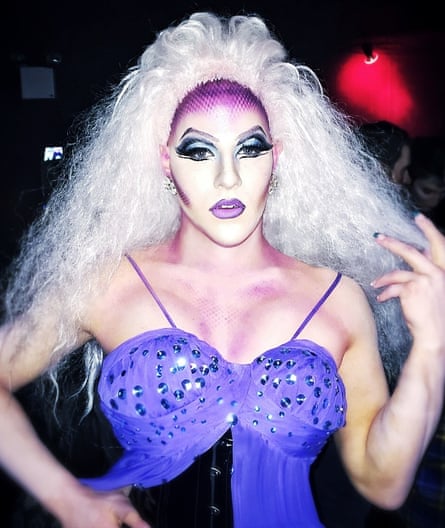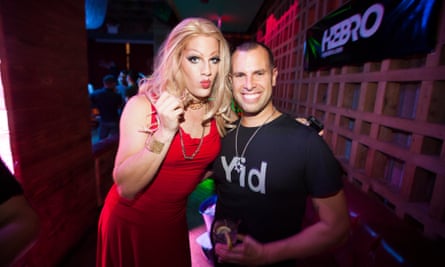This March, one of New York’s up-and-coming drag queens, Lady SinAGAGA, made her debut at Tina Burner’s Invasion, at the historic Stonewall Inn. She began the night in an elegant silk robe, then took it off to reveal a rather sexy bodysuit coupled with knee-high boots. The crowd cheered for her as she sang her soulful rendition of Out Tonight from Rent, her favorite musical.
Lady SinAGaga, as you may have guessed, is a Jewish drag queen (in case you missed it: SinAGaga sounds like synagogue). Her real-life alter ego, Moshiel, 22, was raised Orthodox and came out just over a year ago. He grew up attending Jewish day schools on Long Island, and spent two years studying at a Jerusalem yeshiva, a religious school, before he started at the School of Visual Arts.
Lady SinAGaga is relatively new on the Jewish drag scene, having only debuted at a High Homo Days party (a Jewish gay party hosted by Hebro, an organization working to celebrate the gay Jewish community).
Jewish drag is an entirely new manifestation of the cultural phenomenon; the men who do it have come out and base large parts, if not all, of their drag personas on their Jewish upbringing.
As a new performer on the scene, Lady SinAGaga was nervous. Silvia Sparklestein, a veteran Jewish drag queen, recalls Lady SinAGaga reaching out to her for advice— and some makeup. “I have a pretty extensive makeup collection,” Silvia says. “My first few batches were borrowed and from CVS, but then a friend of mine who used to work for MAC gave me some tips and some products.” She now uses top-of-the-line beauty products. Silvia also has a selection of heels, wigs and outfits; she lends them out to newbies, which is how Lady SinAGaga found her.
In everyday life, Silvia Sparklestein is Yudi K, a 28-year-old interior designer. Yudi grew up as an Orthodox Jew in Staten Island, and still lives an Orthodox lifestyle in Manhattan.
His persona is a 39-year-old big blonde Jewish mama from Queens, New York. She likes to make you feel guilty – think Woody Allen meets Bubbe. She celebrates all the Jewish holidays, often with a new original parody song (most recently, All I Want for Christmas Is Jew). She cooks gefilte fish, kugel and challah. She loves plaid, sequins, tweed and faux fur. As Yudi K sums it up: “Silvia is just very, very Jewish!”

Silvia was born in 2010, when a friend of Yudi K’s hosted a garden party and encouraged all of the guests to “come in their mom’s Sunday best”. Yudi went all out: he borrowed a tweed jacket, got a blonde wig and put on a big pearl necklace.
When Lady SinAGAGA called her for help back in September, she was happy to oblige in any way she could. After all, though there are quite a few Jewish drag queens on the scene, they are still few enough in number that they all support one another.
This support comes in forms other than just makeup advice and fashion tips. Lady SinAGAGA isn’t fully out of the drag closet, and Moshiel’s parents don’t know about her yet. Hebro’s founder, Jayson Littman, explains it thus: “Imagine coming out to your Jewish parents as gay, and then having to tell them, ‘By the way, my nightlife name is Lady SinAGaga.’”
It’s no secret that Orthodox Judaism condemns homosexuality and that many men, like their counterparts from other religious communities that don’t look favorably on homosexuality, struggle to reconcile their religious identity and their sexuality.
Back in 2011, conversations erupted in the Orthodox Jewish community about orthodoxy and homosexuality. The issue caused some major rifts between liberal and conservative Orthodox leaders.
All Orthodox rabbis emphasize the need to be empathetic to the emotional needs and struggles of LGBT people who wish to remain in the religious community, but ultimately none support same-sex marriage, per the biblical tradition.
The real distinction is whether Judaism recognizes that homosexuality could be a real sexual orientation and, as a related point, whether a rabbi could endorse conversion therapy.
The more rightwing Orthodox ideology, as outlined in what is known as the Torah Declaration, outlaws homosexuality in any form. Its proponents claim that, according to the Torah, “homosexuality is not an acceptable lifestyle or a legitimate identity.” Further, the Declaration claims that “same-sex attraction can be modified and healed.”
The Declaration has 223 signatories spanning prominent ultra-Orthodox rabbis, modern Orthodox rabbis and even some mental health professionals – Arthur Goldberg, the co-director of the Jonah Institute of Gender Affirmation, a conversion therapy clinic in New Jersey, signed the document.

There is, however, a more liberal and sympathetic Orthodox approach to homosexuality whose cornerstone is what is known as The Statement of Principles. It states that “all human beings are created in the image of God and deserve to be treated with dignity and respect”; they should “be welcomed as full members of the synagogue and school community”. Unlike the Torah Declaration, it allows for the possibility that same-sex attraction could be natural and inherent.
Signatories of this document include prominent Jewish leaders such as the rabbi emeritus of Congregation Shearith Israel, the oldest Jewish congregation in the US. There are no ultra-Orthodox signatories to the Statement.
When it comes to how to deal with LGBT Jews who wish to remain in the Orthodox community, Jewish law is ambiguous at best. Oftentimes gay men have to choose one over the other: either they will leave their religious community to lead openly gay lives, or they will stifle their sexuality.
A lesser-known fact is that Orthodox Jews also condemn cross-dressing, per the commandment in Deuteronomy 22:5. This issue too is discussed within ancient and modern rabbinic circles, though not nearly to the same extent as the question of homosexuality. This conversation arises in the Talmud and in other sources, pondering whether men are allowed to dress up as women on Purim, the Jewish dress-up holiday – since it seems like the prohibition of cross-dressing is based on the premise of men not being confused and marrying other men, thinking they are women.
And so just like the frum – a Yiddish term for observant – there are also frum drags, who are more extreme than observant gay people because they also cross-dress.
Yudi K fits both of these bills. Though he doesn’t observe Jewish ritual law with the same stringency that he did when he was a child, he still identifies with Orthodox Judaism. He does drag – and he does it as a proud Jew. “The best thing about being a Jewish drag queen,” he says, “is that I can pull from my upbringing and experiences.” In his community, if a topic was uncomfortable, it was usually passed over in silence. “It was like, nothing needed to be said, even if it desperately needed to be,” he says. That is not uncommon in the Orthodox community, where there are many taboos and stigmas. “Being a drag queen frees you up to say whatever the fuck you want.”

Yudi K isn’t alone. The winner of season five of RuPaul’s Drag Race was a Jewish drag queen named Jinkx Monsoon, aka Jerick Hoffer of Portland, Oregon. Hoffer was raised Catholic but when he was 18 found out he was of Russian Jewish descent and became increasingly interested in Judaism.
Hebro’s Littman, who has been described as the mayor of the Jewish gay party scene, remarks: “Drag is very much part of gay culture, and so is Judaism. Some of the gayest parts of LGBT culture are Jewish: Broadway, Barbra Streisand and big hair. Because Judaism is so intertwined with theater and entertainment, professions highly sought out by the gay community, they go together quite well.
“Being a character in drag is all about creating a big, exaggerated personality, and most gay Jews have the perfect role model to imitate for that: our mothers.”
Sherry Vine, Keith Levy’s drag persona, embodies this sentiment. Levy was not raised Orthodox, nor does he identify as such now, but he has a strong Jewish identity. “My dad is a Jewish atheist, and my mom’s side of the family is Baptist,” he says. He always celebrated holidays with his extended family, though, and the Jewish bits of those celebrations “have always been a part of Sherry Vine”. In her Jewish Brooklyn accent, performing full time in clubs and cruise ships around the world, she does a lot of parodies about being Jewish – like her Jappy parody of Pharrell Williams’ Happy.
The blossoming Jewish drag culture, as Littman put it, “shows that our community has come so far that not only have we dealt with many of our issues surrounding coming out, but now we can proudly put on a drag performance with Jewish identities to showcase our alternate Jewishly exaggerated personalities”.
Both Yudi K and Moshiel asked that their last names be withheld because they are still not out as drag queens to their respective Orthodox communities.

Comments (…)
Sign in or create your Guardian account to join the discussion